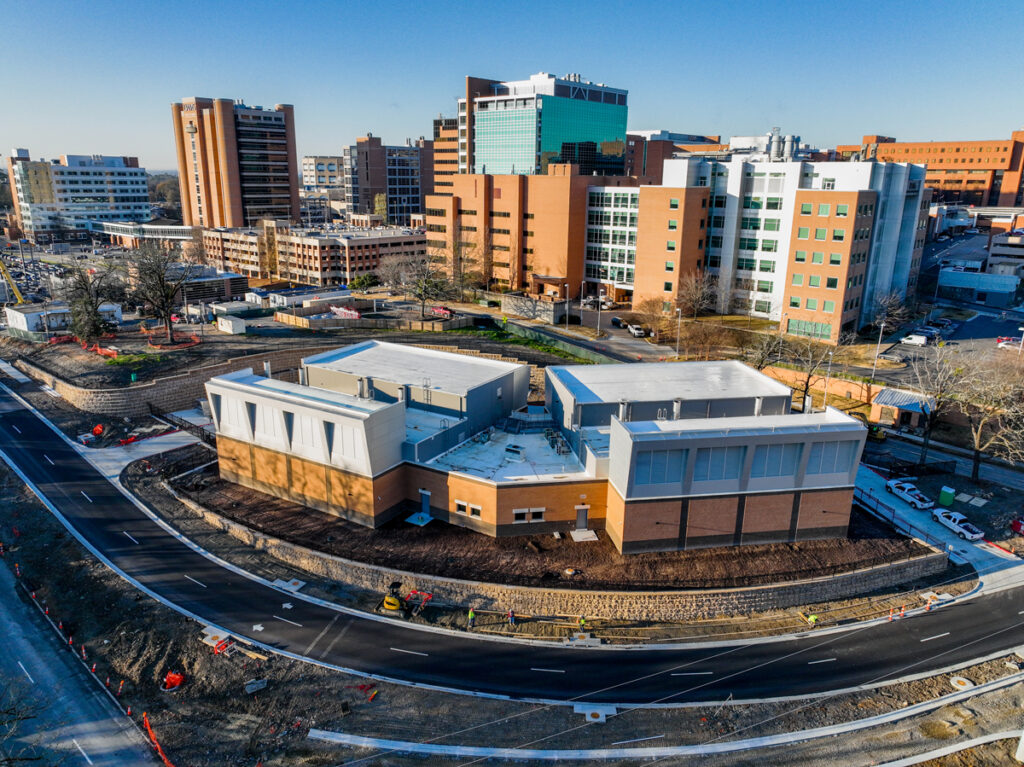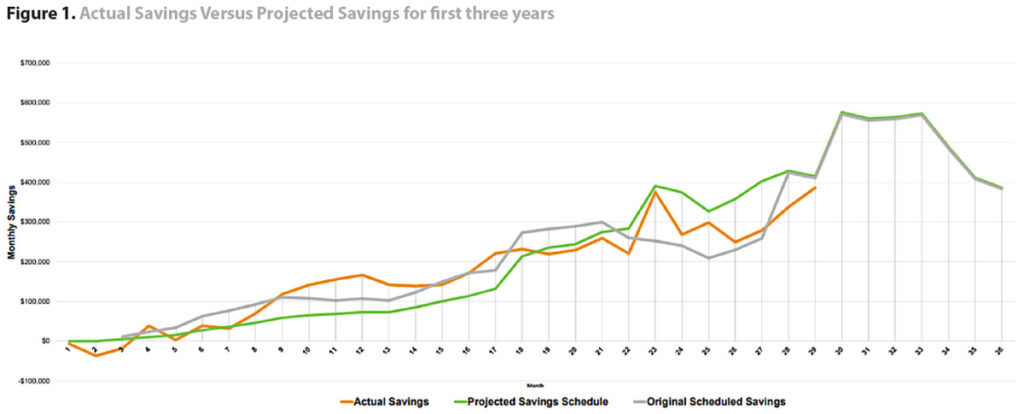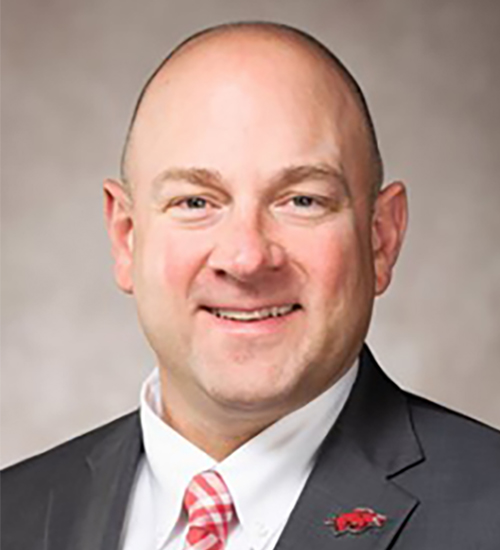Using energy savings to fund sustainability at an Academic Health Center
February 2023 – The Journal of Healthcare Contracting

By Kristie Hadden, Ph.D.; Christina Clark, M.B.A.; Stephanie Gardner, Pharm.D., Ed.D; David Dobrzykowski, Ph.D.; and Cam Patterson, M.D., M.B.A.
Hospitals and labs are responsible for 4.4% of the planet’s greenhouse gas emissions each year, ranking in the top six of the worlds’ largest emitters, and the United States accounts for 27% of the global health care emissions footprint. (Karliner J., et al, 2019) The negative environmental impact of Academic Health Centers (AHCs) on human health is not only misaligned with, it is contrary to the missions of these institutions. Calls to action have been voiced and supported by world and national associations, including the Association of American Medical Colleges (AAMC). These calls demand changes that shift health care institutions from being the biggest contributors of emissions to becoming models for other industries to follow. In response to acknowledging our responsibility to safeguard the health of our communities through mitigating the current environmental crisis, as well as to create a proactive, sustainable model for AHCs, the University of Arkansas for Medical Sciences (UAMS) is making strides towards becoming carbon neutral. Through innovative strategy and financing, radical changes toward reducing our institution’s carbon footprint have been made possible.
UAMS is the only health sciences university in the state, with five graduate colleges and a hospital on its main campus in Little Rock. Our University is committed to addressing climate change and human health in our education and research mission areas, as well as through campus sustainability efforts. Additionally, and in an effort to promote inclusive climate change activism, our campus aims to reduce pollution and the negative impact of its consumption on the vulnerable community that lives in the shadow of its buildings. (North Carolina Environmental Justice Network, 2016) To that end, our leadership prioritized and is now executing a comprehensive facilities plan that is already having a positive impact on sustainability. The plan also addresses many institutional and organizational challenges that are common for academic health centers.
UAMS, like many other academic health centers, faces a strategic challenge of funding critical and deferred maintenance needs across its campus while maintaining energy efficient, state-of-the-art facilities. Innovative funding solutions are required to address these critical needs in a budget-positive manner. Our solution allows energy efficiency, critical infrastructure, and deferred maintenance projects to be completed and paid for over time through guaranteed energy savings, operating cost savings, and avoided capital investments. Leveraging these energy cost savings allows our University to invest more in our programs that support our mission to improve the health and wellbeing of the people in our state through education, research, and clinical care. This article highlights the challenges that led to our innovative facilities approach, describes the processes implemented to achieve lofty facilities goals in Energy Savings Performance Program (ESPP), and illustrates the financial, environmental and other outcomes of the ESPP that may be relevant for other health care facilities in need of energy-related facilities investment.
Innovation
Because UAMS is a state government agency, the facilities transformation began with a Request for Qualifications (RFQ) process to select a local Energy Services Company (ESCO). The three-step RFQ process yielded an ESCO selection based on qualifications and Investment Grade Audit (IGA) price per square foot. The ESCO completed a review of compliance with state standards, confirmed savings methodology, approved contracting structure, and verified overhead/profit/margin fees, cost estimates, and engineers’ credentials. UAMS worked with the ESCO to frame the Energy Savings Performance Project (ESPP), which started in early 2018 and is expected to be fully complete by the end of 2022.
Energy Savings Performance Contracting is a method of contracting that allows energy savings projects to be performed and paid for over time by the guaranteed savings realized in energy bills, operations cost, and avoided capital investments. The enabling state legislation for this is titled “Guaranteed Energy Cost Savings Act.” An excerpt taken from the definitions page of the statute reads: “‘Guaranteed energy cost savings contract’ means a contract for the implementation of one (1) or more energy cost savings measures and services provided by qualified energy service companies in which the energy and cost savings achieved by the installed energy project cover all project costs, including financing, over a specified contract term.” (Arkansas General Assembly, 2019) In other words, for a project to be eligible under this program, we look for facilities or equipment on our campus that are wasting energy, in need of replacement, causing excessive maintenance cost, or would perform better if repaired or upgraded. These are termed Cost Reduction Measures (CRMs). By completing one or more CRMs, a certain amount of energy and operational cost will be saved. Savings can be realized in electricity, gas, fuel oil, water, maintenance, capital, or any other type of operational cost. This savings must be sufficient to pay for the conservation measure, plus the financing fees – and any other project costs – over an acceptable term. The statute sets an upper limit of 20 years for the applicable project. The goals of the ESPP were to positively impact our local environment and to significantly reduce energy costs. Additionally, the ESPP focused on improving campus resiliency by addressing critical infrastructure needs, improving campus safety, and implementing previously approved deferred maintenance requirements. The ESPP approach included the following CRMs:
Retrofitting internal and exterior lighting with LED
Lighting energy costs for typical commercial buildings range from 10% to 15% of a building’s overall utility costs. This can vary greatly depending on building occupancy, function and the type of lighting technology deployed. UAMS has a diverse use of lighting technology across its campus. Based on a lighting audit performed during the Investment Grade Audit (IGA), more than 70,000 fixtures were identified and evaluated for possible retrofit to an LED alternative. LED lighting technology provides a more energy-efficient solution when compared to traditional fluorescent fixtures.
Building new generator plant

UAMS had a 13.5 megawatt (MW) diesel generator plant that allowed the institution the opportunity to participate in our local utility’s demand response program under its Optional Interruptible Service (OIS) rider. (Entergy Arkansas LLC, 2022) The OIS program generates substantial cost savings for UAMS by the utility agreeing to charge the institution a special electric rate since the generator presence allows the utility to shift UAMS and other off-taker participants from the utility’s power grid during peak electric demand. The generator plant provides complete backup to the normal power system on a portion of the UAMS’ campus as well as for the off-takers that include neighboring Arkansas Department of Health and the Arkansas State Hospital facilities. In the ESPP, UAMS constructed a new 24 MW generator plant. The intent is to provide complete backup to the normal power system and take advantage of our local utility’s OIS rate, similar to the previous arrangement.
Upgrading essential power system
In concert with the new generator plant, UAMS also is upgrading the existing essential power system on a portion of the campus to be served from the newly constructed generator plant. UAMS presently has 19 independent generators on campus that serve various buildings and loads. These generators are maintenance intensive and in need of replacement. This upgrade will remove these generators and re-feed the emergency power circuits associated with those loads to the new generator plant.
Retro-commissioning and installation of building energy management controls
Building Automation System (BAS) controls are vital to energy efficient operations. Controls technology has advanced over the last several years with the advent of Direct Digital Controls (DDC), which are far superior to pneumatic controls. However, even the presence of DDC does not ensure energy efficient operations. Controls technology becomes outdated and incorrect implementation of DDC control sequences are seen commonly throughout the industry. Substandard performance is often the result of poor programming and sequence development, even though the controlled equipment is designed to be energy efficient. The ESPP includes upgrading and retro commission of building automation to address the BAS and optimize its operation through two distinct components: 1) upgrading the existing BAS to current technology and 2) retro-commissioning the existing and upgraded BAS to optimize system operation. These two components of the ESPP will generate substantial energy savings and resolve persistent operational and maintenance issues.
Upgrading chilled water and heating water systems
As UAMS uses a chilled-water system for cooling its buildings, part of the ESPP involved upgrading our chilled-water plant from a primary secondary pumping arrangement to a variable primary pumping system. This entails the replacement of existing primary and secondary pumps with new variable speed primary pumps and closing isolation valves on the existing primary secondary decoupler to increase plant pumping efficiency as well as replacing two existing chillers with new standard efficiency chillers to improve chiller plant efficiency. In addition to the these upgrades, the ESPP also includes the upgrade of existing cooling tower cells by replacing six existing cooling tower cells with new cells and extending equalization piping to the new cells such that any cell can be used with any chiller. These upgrades will provide an additional 1,500 tons of cooling tower capacity for our campus.
Replacing critical air handling units
Air Handling Units (AHUs) can have a substantial impact on energy consumption and costs for a building. AHUs are common HVAC equipment seen in most commercial buildings and are responsible for the primary air movement of the HVAC system. AHUs have a finite useful operating life ranging from 20 to 25 years on average. Many AHUs on the UAMS campus have reached or are operating beyond their useful life and are in need of replacement. The ESPP included designing three prioritized AHUs in strategic locations across our campus.
Outcomes of implementation
The ESPP delivered substantial cost savings for the campus (see Figure 1) while also promoting energy efficiency and reducing the impact of the campus physical plant on the environment. The positive financial outcomes included an estimated $4.8 million in annual energy savings and $3.3 million in annual operational cost savings. At the same time, more than 250 trees were planted on the 100-acre campus and more than 65,000 LED light bulbs were installed to replace older, less energy efficient lighting. As a result of the initiatives, UAMS reduced carbon emissions for natural gas and electricity by 32%. Additionally, 19 end-of-life generators were replaced with the eight new generators. The mechanical, electrical and plumbing systems of a 1960s-era building were upgraded and the building is now shelled space for future occupancy, also contributing to significant energy savings.

Conclusion
It is critically important that AHCs’ strategic, transformative approaches include a framework that represents all three mission areas: health care, education and research. By mitigating the negative impact of carbon emissions of our facilities, our institution is addressing the health and health care of our community.
The innovative strategy and financing that has made our institution’s positive environmental impact possible has been realized over time. As savings have been realized, including the $8.1 million saved annually through energy efficiency and operation cost reduction, investments in further improvements have been made. This approach of strategic savings/investment focused on energy and facilities can create opportunities for AHCs and other health care organizations to address health and well-being by creating models of responsibility and sustainability.
About the authors:

Kristie Hadden, Ph.D., is Associate Professor and Senior Strategy Associate in the Office of Strategy Management at the University of Arkansas for Medical Sciences.

Christina Clark, M.B.A., is Vice Chancellor for Support Services and Chief Operations Officer at the University of Arkansas for Medical Sciences.

Stephanie Gardner, Pharm.D., Ed.D., is Provost and Chief Strategy Officer at the University of Arkansas for Medical Sciences.

David Dobrzykowski, Ph.D., is Associate Professor at the JB Hunt Transport Department of Supply Chain Management, Sam M. Walton College of Business, University of Arkansas, and Director of Walton College of Business Healthcare Initiatives.

Cam Patterson, M.D., M.B.A., is chancellor of the University of Arkansas for Medical Sciences.
“The authors would like to acknowledge and thank Jon Parham and Ian Hadden for their important contributions to this article.”
References
Arkansas General Assembly (2019), “The Guaranteed Energy Savings Cost Act, AR Code § 19-11-1206,” available at: https://law.justia.com/codes/arkansas/2019/title-19/chapter-11/subchapter-12/section-19-11-1202 (accessed 19 May 2022).
Entergy Arkansas, LLC (2022), “Optional Interruptible Service Rider,” available at: https://cdn.entergy-arkansas.com/userfiles/content/price/tariffs/eal_ois.pdf?_ga=2.84034777.1721533408.1650653524-139310164.1650653524 (accessed 19 May 2022)
Karliner J., Slotterback S., Boyd R., Ashby B., Steele K. (2019), “Health Care’s Climate Footprint: How the Health Sector Contributes to the Global Climate Crisis and Opportunities for Action,” available at: https://noharm-global.org/sites/default/files/documents-files/5961/HealthCaresClimateFootprint_092319.pdf (accessed 19 May 2022)
North Carolina Environmental Justice Network (2016), “Position Statement On Climate Change,” NEW SOLUTIONS: A Journal of Environmental and Occupational Health Policy, Vol. 26 Issue 1, pp. 115-118.
